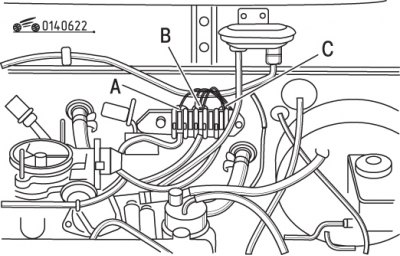Servo diaphragm
Remove the air filter.
Turn off all consumers and disconnect the connector from the electric cooling fan.
Disconnect and plug the idle air compensator hoses, reed valves and temperature sensor.
Warm up the engine to operating temperature and connect the tachometer.
Models equipped with air conditioning

Pic. 6.18. Checking the idle speed compensator (on models equipped with air conditioning): 1 – vacuum control tube; 2 - vacuum supply tube when checking
Disconnect vacuum tube 1 (pic. 6.18).
Attention! Apply a vacuum to the hose and diaphragm through the tee, while the engine speed should increase to 1200–1450 min-1
. If necessary, set the desired engine speed by turning the adjusting screw (pic. 6.19).

Pic. 6.19. Idling Speed Compensator Diaphragm Adjustment (on models equipped with air conditioning)
Models equipped with power steering
Remove the air filter.
Turn off all consumers and disconnect the connector from the electric cooling fan.
Disconnect and plug the idle air compensator hoses, reed valves and temperature sensor.
On models equipped with air conditioning, check and adjust the servo diaphragm.

Pic. 6.20. Checking the diaphragm of the speed compensator of the crankshaft of the engine idling (on models equipped with power steering): 1 – vacuum control tube; 2 - vacuum supply tube when checking
Disconnect vacuum tube 1 (pic. 6.20) and apply vacuum through the tee to the hose and diaphragm.
The engine speed should increase to 800–1000 for manual transmission models and to 1050–1250 min-1 for automatic transmission models. If necessary, disconnect the vacuum hose and set the required frequency by turning the adjusting screw (pic. 6.21).

Pic. 6.21. Idling Speed Compensator Diaphragm Adjustment (on models equipped with power steering)
Connect the vacuum hose and check the engine idle speed again.
Three-way valve
A three-way valve is connected between the intake manifold and the servo diaphragm.

Pic. 6.22. Purpose of controlled vacuum channels on a three-way solenoid valve: And – the valve of the hydraulic booster of a steering; B - ACVN2 air conditioner valve; C - air conditioning valve
On models equipped with air conditioning, the three-way valve turns off the vacuum supply in accordance with the signal sent to the control unit from the air conditioner switch. On models equipped with power steering, a three-way valve cuts off the vacuum supply in response to a signal from the power steering switch (pic. 6.22).

Pic. 6.23. Extension of the servo-diaphragm rod with a working three-way valve
Turn on the air conditioner (the engine must be idling). If the valve is in good condition, then the servo-diaphragm rod extends (pic. 6.23).
Switch off the conditioner and turn a steering wheel against the stop to the right or to the left. If the three-way valve and power steering switch are OK, then the servo diaphragm rod extends.
Power steering switch

Pic. 6.24. Power Steering Switch Circuit Test
Disconnect the connector from the power steering switch and check the continuity of the circuit through the switch in accordance with Fig. 6.24. With the engine idling, turn the steering wheel all the way to the right or left - the switch must be in the closed position.
